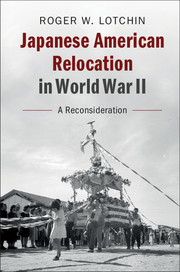Japanese American Relocation in World War II A Reconsideration
Langue : Anglais
Auteur : Lotchin Roger W.

Lotchin argues that the World War II relocation of Japanese-Americans was motivated by fear of Japan, rather than racism.
In this revisionist history of the United States government relocation of Japanese-American citizens during World War II, Roger W. Lotchin challenges the prevailing notion that racism was the cause of the creation of these centers. After unpacking the origins and meanings of American attitudes toward the Japanese-Americans, Lotchin then shows that Japanese relocation was a consequence of nationalism rather than racism. Lotchin also explores the conditions in the relocation centers and the experiences of those who lived there, with discussions on health, religion, recreation, economics, consumerism, and theater. He honors those affected by uncovering the complexity of how and why their relocation happened, and makes it clear that most Japanese-Americans never went to a relocation center. Written by a specialist in US home front studies, this book will be required reading for scholars and students of the American home front during World War II, Japanese relocation, and the history of Japanese immigrants in America.
Introduction: relocation, a racial obsession; Part I. The Reach of American Racism?: 1. Racism and anti-racism; 2. The ballad of Frankie Seto: winning despite the odds; 3. Chinese and European origins of the West Coast alien dilemma; 4. Impact of World War II: a multicausal brief; 5. The lagging backlash; 6. The looming Roberts Report; 7. Races and racism; Part II. Concentration Camps or Relocation Centers? Definitions versus Historical Realities: 8. Definition versus historical reality: concentration camps in Cuba, South Africa, and the Philippines; 9. Resistance or cooperation?; 10. Bowling in Twin Falls – an open-door leave policy; 11. Daily life: food, labor, sickness, and health; 12. Wartime attitudes toward relocation; 13. Family life, personal freedom, and combat fatigue; 14. Economics and the dust of Nikkei memory; 15. Consumerism: shopping at Sears; 16. The leisure revolution: Mary Kagoyama, the sweetheart of Manzanar; 17. Of horse stalls and modern 'memory' – housing and living conditions; 18. Politics; 19. Culture: of Judo and the Jive bombers; 20. Freedom of religion; 21. Education, the passion of Dillon Myer; 22. The right to know, information and the free flow of ideas; 23. Administrators and administration; Part III. The Demise of Relocation: 24. Politics of equilibrium – friends and enemies on the outside; 25. Endgame: termination of the centers; 26. Conclusion: the place of race; 27. Appendix: Historians and the Racism and Concentration Camp Puzzles by Zane l. Miller.
Roger Williams Lotchin is Emeritus Professor in the Department of History at the University of North Carolina, Chapel Hill, where he taught for almost 50 years. He is specialist in US home front studies and war and urban society, and the author of numerous books and articles, including Fortress California, 1910–1961: From Warfare to Welfare (1992), The Bad City in the Good War: San Francisco, Los Angeles, Oakland, and San Diego (2003), and San Francisco, 1846–1856: From Hamlet to City (1974).
Date de parution : 05-2018
Ouvrage de 362 p.
15.2x22.8 cm
Date de parution : 05-2018
Ouvrage de 362 p.
15.7x23.5 cm
Disponible chez l'éditeur (délai d'approvisionnement : 14 jours).
Prix indicatif 86,50 €
Ajouter au panierThème de Japanese American Relocation in World War II :
© 2024 LAVOISIER S.A.S.



